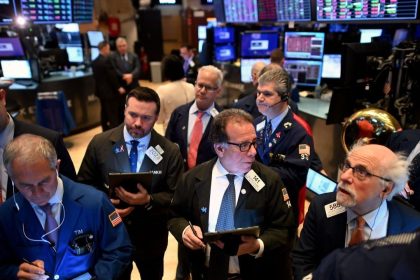Images by GettyImages; Illustration by Hunter Newton/Bankrate
There are many ways that investors try to predict future stock price movements. One of those tactics is identifying a dead cat bounce — a term coined on the theory that even a dead cat would bounce if it fell from a great enough height at a fast enough speed.
In investing, a dead cat bounce is a temporary recovery in an asset’s price during a prolonged decline. For example, a stock’s price starts falling, temporarily increases, then continues dropping. These brief, and often sharp, spikes within a downward slide are also called a sucker rally or bear market rally.
Here’s what you need to know about a dead cat bounce and what investors can learn from a dead cat bounce, even though it’s generally only identified in hindsight.
What is a dead cat bounce?
A dead cat bounce is a short-lived recovery in the price of a declining asset just after a significant, long-term drop but right before the price continues its downward trend. A dead cat bounce typically happens after a long-term period of market decline.
Here are a few reasons a dead cat bounce can occur.
- Market news: Financial markets are influenced by news and speculation. After a long-term decline, positive news regarding an asset could drive up the price.
- Profit taking: When a stock bounces back temporarily after a decline, some investors sell their shares to take profits. This selling can also drive the price up briefly, even if the overall trajectory remains negative.
- Fundamental weakness: In a dead cat bounce, temporary rises in price usually aren’t backed by the asset’s fundamentals or underlying economic conditions may be weak. In other words, the spike is caused by an external factor, à la Roaring Kitty and the GameStop run-up, not a company’s financials. Factors like decreased revenue or increased competition can contribute to this weakness.
- Speculation: Technical day traders look for patterns to identify and buy into a rebound, causing other investors to do the same, hoping to capitalize on the momentum. Some investors just bet on a short-term recovery without assessing the asset’s fundamentals and instead use other indicators, like moving averages.
- Optimism: After a market downturn, investors may hope that the worst is over and buying pressure increases as optimism rises, sparking a quick and short-lived bump in the price of a stock despite the underlying fundamentals or economy being weak.
What does a dead cat bounce tell investors?
A dead cat bounce is typically only identified after the fact when time shows how the price played out. That said, a dead cat bounce may indicate that a temporary recovery without a tangible reason could be short-lived and a long-term rise in price isn’t on the horizon. The brief spike may also signal caution to investors about the overall market and broader economic conditions.
Of course, there is the potential for a false alarm. A dead cat bounce by definition is when an asset’s price continues to decline after a short rise. If an asset doesn’t continue its downward trend, it may be headed toward a genuine recovery or level off instead. Again, only time will tell, though data — such as a strong or weak earnings report — may indicate if the spike is warranted or not.
Dead cat bounce example
In mid-2008, the Dow Jones Industrial Average (DJIA) experienced a dead cat bounce — steadily falling from about 13,000 in April, rallying to around 11,700 in August, then declining again to hit a low in the mid-6,000s in early 2009. While the Dow itself is an index, rather than an asset like stocks or bonds, it serves as a valuable indicator of overall market sentiment and health.
Some investors, fueled by optimism, believed the economy was on the mend rather than headed toward a recession, which spurred buying and drove the index up. However, shortly after this brief rise, the index hit its lowest point.
As the index bounced back, it gave investors a false sense of hope. Several economic indicators — such as lower unemployment and GDP growth — looked promising, but underlying market fundamentals were weak in the midst of the Great Recession.
Hindsight is 20/20 when it comes to identifying a dead cat bounce, but these past bounces highlight the importance of recognizing market recoveries can be short-lived and sometimes there are bigger issues at play.
How is a dead cat bounce different from fundamental analysis?
A dead cat bounce falls under a category of investing analysis called technical analysis, a method that focuses on analyzing price movements and trading volumes in an attempt to predict future price behavior. Investors often use historical data, charts, moving averages and other data to determine these price movements.
Fundamental analysis, on the other hand, is a method of research that investors use to determine the intrinsic value, or true underlying worth, of a stock or asset. Fundamental analysis calculates this value by analyzing factors such as revenue, earnings and profit margin. The goal is to determine whether a stock is overvalued (priced higher than its intrinsic value) or undervalued (priced lower than its intrinsic value). Fundamental analysis focuses more on the underlying economic factors and financial metrics that go into analyzing a long-term investment rather than a short-term buy, sell or trade.
Bottom line
A dead cat bounce is a short-lived gain in a declining asset’s price followed by another steep drop. This can happen because of news, market speculation or weak fundamentals. In general, investors should be cautious when it comes to jumping into an asset based on a short-lived price increase. Instead, long-term investors should focus on the asset’s fundamentals rather than relying solely on how the price is moving.
Read the full article here


















